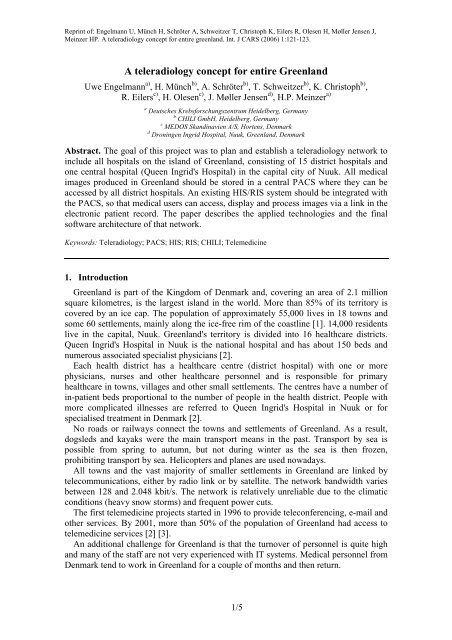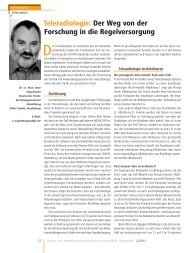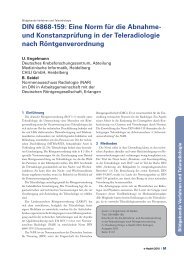A teleradiology concept for entire Greenland - Chili
A teleradiology concept for entire Greenland - Chili
A teleradiology concept for entire Greenland - Chili
Create successful ePaper yourself
Turn your PDF publications into a flip-book with our unique Google optimized e-Paper software.
Reprint of: Engelmann U, Münch H, Schröter A, Schweitzer T, Christoph K, Eilers R, Olesen H, Møller Jensen J,<br />
Meinzer HP. A <strong>teleradiology</strong> <strong>concept</strong> <strong>for</strong> <strong>entire</strong> greenland. Int. J CARS (2006) 1:121-123.<br />
A <strong>teleradiology</strong> <strong>concept</strong> <strong>for</strong> <strong>entire</strong> <strong>Greenland</strong><br />
Uwe Engelmann a) , H. Münch b) , A. Schröter b) , T. Schweitzer b) , K. Christoph b) ,<br />
R. Eilers c) , H. Olesen c) , J. Møller Jensen d) , H.P. Meinzer a)<br />
a Deutsches Krebs<strong>for</strong>schungszentrum Heidelberg, Germany<br />
b CHILI GmbH, Heidelberg, Germany<br />
c MEDOS Skandinavien A/S, Hortens, Denmark<br />
d Droningen Ingrid Hospital, Nuuk, <strong>Greenland</strong>, Denmark<br />
Abstract. The goal of this project was to plan and establish a <strong>teleradiology</strong> network to<br />
include all hospitals on the island of <strong>Greenland</strong>, consisting of 15 district hospitals and<br />
one central hospital (Queen Ingrid's Hospital) in the capital city of Nuuk. All medical<br />
images produced in <strong>Greenland</strong> should be stored in a central PACS where they can be<br />
accessed by all district hospitals. An existing HIS/RIS system should be integrated with<br />
the PACS, so that medical users can access, display and process images via a link in the<br />
electronic patient record. The paper describes the applied technologies and the final<br />
software architecture of that network.<br />
Keywords: Teleradiology; PACS; HIS; RIS; CHILI; Telemedicine<br />
1. Introduction<br />
<strong>Greenland</strong> is part of the Kingdom of Denmark and, covering an area of 2.1 million<br />
square kilometres, is the largest island in the world. More than 85% of its territory is<br />
covered by an ice cap. The population of approximately 55,000 lives in 18 towns and<br />
some 60 settlements, mainly along the ice-free rim of the coastline [1]. 14,000 residents<br />
live in the capital, Nuuk. <strong>Greenland</strong>'s territory is divided into 16 healthcare districts.<br />
Queen Ingrid's Hospital in Nuuk is the national hospital and has about 150 beds and<br />
numerous associated specialist physicians [2].<br />
Each health district has a healthcare centre (district hospital) with one or more<br />
physicians, nurses and other healthcare personnel and is responsible <strong>for</strong> primary<br />
healthcare in towns, villages and other small settlements. The centres have a number of<br />
in-patient beds proportional to the number of people in the health district. People with<br />
more complicated illnesses are referred to Queen Ingrid's Hospital in Nuuk or <strong>for</strong><br />
specialised treatment in Denmark [2].<br />
No roads or railways connect the towns and settlements of <strong>Greenland</strong>. As a result,<br />
dogsleds and kayaks were the main transport means in the past. Transport by sea is<br />
possible from spring to autumn, but not during winter as the sea is then frozen,<br />
prohibiting transport by sea. Helicopters and planes are used nowadays.<br />
All towns and the vast majority of smaller settlements in <strong>Greenland</strong> are linked by<br />
telecommunications, either by radio link or by satellite. The network bandwidth varies<br />
between 128 and 2.048 kbit/s. The network is relatively unreliable due to the climatic<br />
conditions (heavy snow storms) and frequent power cuts.<br />
The first telemedicine projects started in 1996 to provide teleconferencing, e-mail and<br />
other services. By 2001, more than 50% of the population of <strong>Greenland</strong> had access to<br />
telemedicine services [2] [3].<br />
An additional challenge <strong>for</strong> <strong>Greenland</strong> is that the turnover of personnel is quite high<br />
and many of the staff are not very experienced with IT systems. Medical personnel from<br />
Denmark tend to work in <strong>Greenland</strong> <strong>for</strong> a couple of months and then return.<br />
1/5
Reprint of: Engelmann U, Münch H, Schröter A, Schweitzer T, Christoph K, Eilers R, Olesen H, Møller Jensen J,<br />
Meinzer HP. A <strong>teleradiology</strong> <strong>concept</strong> <strong>for</strong> <strong>entire</strong> greenland. Int. J CARS (2006) 1:121-123.<br />
There are no local IT people in the district hospitals and IT companies have no<br />
subsidiaries in <strong>Greenland</strong>. A central IT team at the hospital in Nuuk has to take care of<br />
all IT installations. In case of hardware failures they have to contact the next<br />
subsidiaries of IT companies in Denmark. On-site support is not provided by any<br />
hardware supplier. As a result, a high priority request is that the hardware <strong>for</strong> a<br />
<strong>teleradiology</strong> network be as reliable as possible and that untrained personnel can replace<br />
defective hardware themselves.<br />
The goal of this project was to plan and establish a <strong>teleradiology</strong> network to include<br />
all the hospitals in <strong>Greenland</strong>, consisting of the 15 remote district hospitals and the<br />
central national hospital (Queen Ingrid's Hospital) in the capital city of Nuuk. All<br />
medical images produced in <strong>Greenland</strong> should be stored in a central PACS where they<br />
can be accessed by each district hospital. The existing HIS/RIS should be connected to<br />
the PACS, so that medical users can access, display and process images via a link in the<br />
electronic patient record. The following sections describe the applied technologies and<br />
the final software architecture of that network.<br />
2. Material<br />
The objective was to connect the <strong>teleradiology</strong> network with existing IT systems or<br />
systems which were currently in the planning or installation process, such as a global<br />
hospital in<strong>for</strong>mation system, resp. radiology in<strong>for</strong>mation system and a central PACS<br />
server in the central Queen Ingrid's Hospital in Nuuk (all provided by Medos AG,<br />
Langenselbold, Germany). New modalities would be installed along with the<br />
establishment of the <strong>teleradiology</strong> network.<br />
3. Methods<br />
3.1 Global Architecture<br />
A star-like network architecture has been created. The 15 remote district hospitals<br />
produce computed radiographs (Fuji XG-1) only. The technician sends all produced<br />
images to a local <strong>teleradiology</strong> gateway (TR-GW) using DICOM protocol. The TR-<br />
GWs are the key components in this network. They have been established from<br />
components of the CHILI Software Family (CHILI GmbH, Heidelberg, Germany) [4].<br />
CHILI is a set of software components which can be easily configured <strong>for</strong> different<br />
application scenarios and protocols. Systems are in daily clinical use in several<br />
countries, such as Germany, Switzerland, Belgium, USA and China. CHILI supports the<br />
usage of different protocols (DICOM, HTTPS, DICOM-E-Mail, etc.) and has integrated<br />
security and failure measures. The software runs on powerful PACS servers [5] as well<br />
as on PDAs [6]. The existing software components have been adapted and expanded to<br />
the specific needs of this project.<br />
The <strong>teleradiology</strong> network is established by a central <strong>teleradiology</strong> gateway in Queen<br />
Ingrid's Hospital in Nuuk (see Fig. 1). This gateway is connected to the central PACS<br />
and RIS which hold all image data and reports <strong>for</strong> the whole of <strong>Greenland</strong>. <strong>Greenland</strong>’s<br />
other 15 district hospitals are equipped with <strong>teleradiology</strong> gateways (TR-GW) which are<br />
connected to the central gateway. The purpose of the TR-GWs is to transmit all<br />
incoming data to the central system in Nuuk. The central gateway auto-routes all images<br />
to the existing PACS/HIS/RIS systems.<br />
2/5
Reprint of: Engelmann U, Münch H, Schröter A, Schweitzer T, Christoph K, Eilers R, Olesen H, Møller Jensen J,<br />
Meinzer HP. A <strong>teleradiology</strong> <strong>concept</strong> <strong>for</strong> <strong>entire</strong> greenland. Int. J CARS (2006) 1:121-123.<br />
1 of 15 remote<br />
District Hospitals<br />
Central<br />
Queen Ingrid‘s<br />
Hospital in<br />
NUUK<br />
TR Gateway<br />
CHILI/Web<br />
Cache<br />
AutoRouter<br />
CHILI Protocol<br />
AutoRouter<br />
Cache<br />
CHILI/Web<br />
Central TR-Gateway (Webserver)<br />
3/5<br />
HTTP<br />
DICOM<br />
DICOM<br />
Fig. 1. (Simplified) data flow and architecture of the central and remote TR-Gateways<br />
3.2 External Teleradiology Gateways<br />
The external gateways (at the remote district hospitals) have several tasks. They store<br />
the locally produced images in a local cache (PostgreSQL database). If transmission to<br />
the central gateway is interrupted, the external gateways continue the interrupted<br />
transfer automatically when the network is up again. Previously transmitted images are<br />
not transmitted again. All images of a DICOM association are kept together.<br />
Furthermore, the gateway has a built-in webserver which provides all stored images to<br />
the local network in the district hospital. A Java applet is provided by the CHILI<br />
webserver which enables local PC users to display and manipulate the images. No<br />
specific software is necessary on the client PCs of the users, except support <strong>for</strong> the Java<br />
runtime environment which is also provided by the webserver [7].<br />
If the disks of the gateway reach a certain limit of usage capacity, images are<br />
removed from the disks automatically. Specific criteria, such as the age of the study or<br />
last access can be defined. Only the image files are removed. All meta data in the<br />
database regarding the patient and report data are kept. If the user accesses a study<br />
which no longer has the image files on the local disk, these are loaded from the central<br />
<strong>teleradiology</strong> gateway in Nuuk. Even if the image files have been removed they are<br />
automatically retrieved from the central PACS via DICOM Query/Retrieve [7]. Finally,<br />
the user in the district hospital will receive and view the images in his local<br />
HTTP<br />
HTTP<br />
PCs<br />
CR<br />
PACS<br />
PCs
Reprint of: Engelmann U, Münch H, Schröter A, Schweitzer T, Christoph K, Eilers R, Olesen H, Møller Jensen J,<br />
Meinzer HP. A <strong>teleradiology</strong> <strong>concept</strong> <strong>for</strong> <strong>entire</strong> greenland. Int. J CARS (2006) 1:121-123.<br />
environment. Associated reports can also be displayed in the Java applet of the<br />
webserver. They are fetched online from the central HIS.<br />
3.3 Workflow<br />
When a new study arrives at a <strong>teleradiology</strong> gateway, it retrieves the meta<br />
in<strong>for</strong>mation of other existing studies of the same patient from the central <strong>teleradiology</strong><br />
gateway. The image data is not transferred at this stage - only the meta data. The image<br />
data is fetched the moment a user selects the study in the database.<br />
Because the transfer of a study can take some time, the system indicates which<br />
images are online and which are nearline. The user is in<strong>for</strong>med about a request which<br />
might take several minutes and receives a message as soon as the requested study is<br />
online. This mechanism allows the authorised medical staff to access all images of a<br />
patient, no matter where in <strong>Greenland</strong> the image study has been produced.<br />
3.4 The Central Teleradiology Gateway<br />
The <strong>teleradiology</strong> gateway in the central hospital has the same functionality as the<br />
external gateways. With its built-in webserver it provides all images to the <strong>entire</strong><br />
hospital. Users can access the images directly through the database interface of the<br />
webserver or through the electronic patient record which provides links to the specific<br />
image study in the context of the current patient and case.<br />
3.5 User Authentication<br />
User authentication is an important aspect of such a system. A central directory<br />
service (e-directory; Novell Inc.) is used by all in<strong>for</strong>mation systems <strong>for</strong> this purpose.<br />
Local emergency accounts have been created in the event that the central e-directory is<br />
not available (e.g. network interruptions caused by heavy snow storms). Furthermore, a<br />
so-called ticket system is used to implement “single-sign-on”. This means that a ticket<br />
is passed from the HIS to the webserver which grants temporary access to a specific set<br />
of images.<br />
3.6 System Hardware and Operating System<br />
Special attention had to be given to fault-tolerance and easy replacement of defective<br />
parts of the hardware. Intel-based 19” rack servers (ProLiant Series, HP) with the<br />
operating system SuSE Linux Enterprise Server (SLES, Novell Inc.) have been selected<br />
<strong>for</strong> the <strong>teleradiology</strong> gateways. They are all equipped with two mirrored disks (Raid-1)<br />
and redundant power supplies. All systems are protected by an uninterruptible power<br />
supply (UPS) to protect the computers from power failures. The host per<strong>for</strong>ms an<br />
automatic shutdown when the UPS reports a power failure and boots automatically once<br />
the power is returned.<br />
The disks of the gateways are mirrored with Raid-1 technology. The operation of the<br />
system is not affected if one of the two disks fails. The latter can easily be replaced by a<br />
new one by non-experts. An <strong>entire</strong> pre-configured backup system is provided in the<br />
central hospital in the event of more severe hardware breakdowns.<br />
3.7 Measures against software and data loss<br />
Appropriate measures have been implemented <strong>for</strong> the easy restoration of the software<br />
configuration. Mondo Rescue is used to create one or more bootable rescue CD images<br />
based on the server’s filesystem [8]. In the event of catastrophic data loss, even users<br />
with little IT background are able to restore the <strong>entire</strong> system. Changes in the<br />
configuration after the last Mondo backup are saved at several locations.<br />
4/5
Reprint of: Engelmann U, Münch H, Schröter A, Schweitzer T, Christoph K, Eilers R, Olesen H, Møller Jensen J,<br />
Meinzer HP. A <strong>teleradiology</strong> <strong>concept</strong> <strong>for</strong> <strong>entire</strong> greenland. Int. J CARS (2006) 1:121-123.<br />
Application data, such as medical images and reports, are temporarily unavailable if a<br />
<strong>teleradiology</strong> gateway has to be re-established after a complete breakdown. But as soon<br />
as new data is created in the district hospital, the system automatically receives all meta<br />
in<strong>for</strong>mation of existing studies of the same patient from the central <strong>teleradiology</strong><br />
gateway, resp. the PACS/RIS behind (see section 3.3), <strong>for</strong> the user to access and display<br />
them. Another way to view older image studies is to access the central CHILI webserver<br />
directly.<br />
4. Results<br />
The requirements of the project have been met by a transparent DICOM<br />
communication over slow and unreliable network links. All images of a DICOM<br />
association are kept together by means of different transmission strategies and recovery<br />
procedures. Only those images which have not yet been transmitted are sent again. This<br />
protects the system against network interruptions and data loss.<br />
All authorised users have access to all images and reports created in the <strong>entire</strong><br />
<strong>teleradiology</strong> network of <strong>Greenland</strong>. The <strong>teleradiology</strong> solution is seamlessly integrated<br />
into the PACS/RIS systems and the user can access and display images from the context<br />
of the electronic patient record or directly via the image webserver. Single-sign-on and<br />
ticket mechanisms prevent that the user has to log into each in<strong>for</strong>mation system<br />
separately.<br />
Several measures in the architecture, in the hardware setup and in backup and<br />
recovery mechanisms ensure a robust system which can be recovered easily even after a<br />
severe failure.<br />
5. Conclusion<br />
It is possible to establish reliable blackbox solutions to transmit images and reports<br />
over unreliable networks over long distances, thus supporting medical care <strong>for</strong> people in<br />
inaccessible regions.<br />
References<br />
[1] Karlsen KO. Telemedicine in <strong>Greenland</strong>. In: International Telecommunication Union (ITU).<br />
http://www.itu.int/ITU-D/fg7/case_library/documents/telegreen006.html [Accessed 07.07.2006].<br />
[2] Aaen-Larsen B. Health care in the circumpolar world: <strong>Greenland</strong>. Int J Circumpolar Health. 2004;63<br />
Suppl 2:49-53.<br />
[3] Stensgaard T, Sorensen T. Telemedicine in <strong>Greenland</strong> - the creation of an evaluation plan. J Telemed<br />
Telecare. 2001;7 Suppl 1:37-8.<br />
[4] CHILI GmbH, Heidelberg. List of CHILI related publications. http://www.chiliradiology.com/de/pub/<br />
[Accessed 07.07.2006].<br />
[5] Engelmann U, Schröter A, Schwab M, Eisenmann U, Bahner L, Delorme S, Hahne H, Meinzer HP.<br />
The Linux-based PACS project at the German Cancer Research Center. Lemke HU, Inamura K,<br />
Farman AG, Doi K (Eds). CARS 2000: Computer Assisted Radiology and Surgery. Proceedings of<br />
the 14th International Congress and Exhibition. Amsterdam: Elsevier (2000) 41 9-424.<br />
[6] Schweitzer T, Engelmann U, Schroeter A, Boräv E, Grandy M, Meinzer HP. Ubiquitous radiology:<br />
The scalable CHILI architecture on stationary and mobile devices. Niinimaäki J, Ilkko E, Reponen J<br />
(eds). Proceedings of the 20th EuroPACS annual meeting, 5th-7th September 2002, Oulu, Finland.<br />
Publication series of Radiological Society of Finland. Oulu: Oulu University Press (2002) 113-116.<br />
[7] Münch H, Engelmann U, Schröter A, Meinzer HP. The integration of medical images with the<br />
electronic patient record and their web-based distribution. Acad Radiol 2004; 11:661-668.<br />
[8] Mondo Rescue project. http://www.mondorescue.org/ [Accessed 07.07.2006].<br />
5/5





